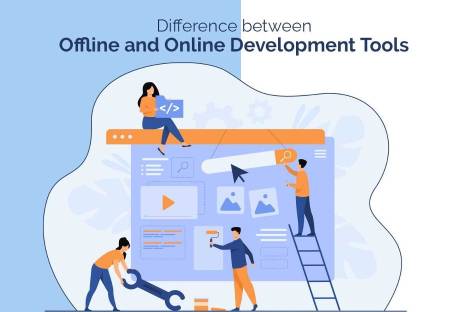Development tools are typically programs or applications that allow developers to create, edit, maintain, support, and debug applications, frameworks, or programs. Various developer tools exist, including linkers, compilers, editors, designers, etc. What development tools an organization or individual selects depends entirely on the project they are working on. According to TechCrunch, tools are having a significant impact on development. Thanks to the advancements in technology, online and offline development tools are readily available in the market. This article will cover all the significant differences between offline and online development tools.

Significant Differences Between Offline and Online Development Tools
Even though both manage to get the job done, there are several differences between offline and online development tools in various aspects. Here are some of them:
- Accessibility
One of the most crucial areas where online and offline development tools differ is accessibility. As the name suggests, you need to have an internet connection to access an online development tool. On the other hand, you can access offline development tools any time you want. All you need to have is your system with you, and you can work on your project anytime. This provides offline development tools an edge over their online counterparts. Let us consider an example. GitHub, an online development website, features tons of development tools. However, one should have a constant internet connection to keep working. If there is no net, you do not get to work. Now, let us consider an offline development toolkit, DevUtils. It is an offline development toolkit that offers users the ability to work entirely offline. Users can choose to work with any tool and work on their Mac locally without needing a network connection.
- Reliability
If you use an online development tool to work on a project, there is always a possibility of the tool facing server issues. If this happens, all the progress you made could get erased within the blink of an eye. You would need to start working from scratch again. In the case of offline development tools, users always get to have a backup of their data because all the work is done locally, and there are very less chances of the data getting erased or deleted. Therefore, in this aspect too, offline development tools register a win.
- Source Code Editing
The majority of the online development tools do not allow users to edit the source code, at least not directly. On the other hand, many offline development tools allow users to directly edit the source code from the application itself. This makes offline development tools more flexible and value-for-money offerings than online tools.
- Transparency
In the case of offline development tools, most of the applications or software offer what they advertise. If you choose a reputed development tool, the chances of getting what you see are very high. Some online development tools advertise a lot, but when the user signs up and decides to start working, the features’ reality often is very disappointing. Point to note – It is not a generalized fact that online development tools are always a scam and offline development tools are always on point. The bottom line is – before choosing any of the two, ensure that you do proper research on the website or company offering the tools and confirm whether their offering is reliable or not.
- Updates
Offline development tools need to stay up-to-date if the user wants to use all the top features that the application or software offers. Therefore, updating the application or software is an additional responsibility for those who use an offline tool. However, this is not the case with online development tools. All the updates are automatically updated and installed, and thus, the user does not need to worry about checking in frequently for new updates.
- Installation
Web-based development tools do not require installation. To use them, all you need to do is navigate to the tool’s official website, log in to your account, and start working. To use an offline development tool, you need to install the official application and, if required, install additional plugins. Thus, online development tools have the upper hand in this case.
- Value for Money
Most of the offline development tools that are available currently ask for a one-time amount from users who wish to purchase the software. Once the app is purchased, you do not need to pay any more money to use any of the application’s features. Some of them also follow a monthly subscription system. In the case of specific online development tools, users generally have to pay to use and implement certain features.
Both online and offline development tools have their own sets of advantages and disadvantages. Make sure that you choose the one that perfectly delivers all your development requirements.





